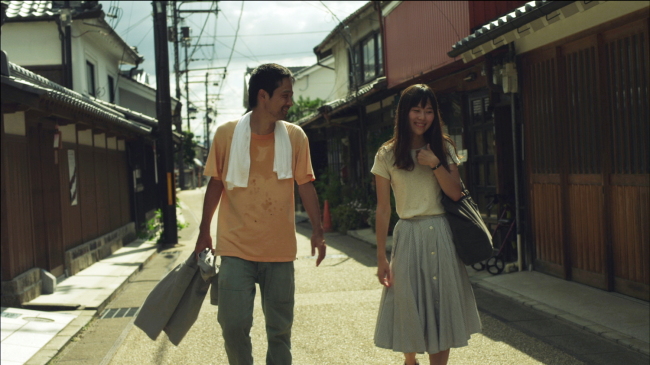Impressions of a quiet rural city unfold in ‘A Midsummer’s Fantasia’
Seeing the hidden city of Gojo through director Jang Kun-jae’s eyes
By Won Ho-jungPublished : June 8, 2015 - 18:56
“A Midsummer’s Fantasia” is being marketed as a romance movie, but its director, Jang Kun-jae, thinks of it as more of a road movie. “That’s what I intended,” he said in an interview.
The film, set to open in local theaters this week, takes place in Gojo, a sparsely populated city in Nara prefecture, Japan. It was a collaborative project between Jang and Cannes-acclaimed Japanese director Kawase Naomi, who joined as a producer.
Although Kawase had lived and filmed in the area for many years, Jang knew almost nothing about the city. He said that as he explored Gojo, he wanted to create a film that captured his impression of the town.
The film, set to open in local theaters this week, takes place in Gojo, a sparsely populated city in Nara prefecture, Japan. It was a collaborative project between Jang and Cannes-acclaimed Japanese director Kawase Naomi, who joined as a producer.
Although Kawase had lived and filmed in the area for many years, Jang knew almost nothing about the city. He said that as he explored Gojo, he wanted to create a film that captured his impression of the town.

“I found that the locals had a lot of stories to tell, stories that were not immediately apparent from an outsider’s perspective,” he said.
In its final form, “A Midsummer’s Fantasia” is split into two halves, a black-and-white first half and a full-color second half.
“It’s like a decalcomania. There are the same elements on both sides. They look similar, but they’re different. I wanted the two stories to be parallel, like events in a Murakami Haruki novel.”
The first half follows a film director named Tae-hoon (Lim Hyung-kook) and his interpreter Mi-jeong (Kim Sae-byuk) as they explore Gojo, looking for places to film Tae-hoon’s next movie. The experiences of the characters are not very different from those of Jang himself.
“I wanted the first half to feel like a documentary. I personally got the feeling that Gojo was a monochromatic city, because there were so few people, which is why I chose a black-and-white tone,” he said. “I also strictly limited the movement of the camera to keep it still.”
Jang said that the first half was meant to be experienced from the perspective of the director Tae-hoon, which was why it could feel confusing. “Tae-hoon is completely dependent on his interpreter. I left out subtitles for a lot of the Japanese dialogue so that the audience would only understand as much as Tae-hoon did.” The focus is on discovering the sights and the people of Gojo, rather than telling any particular kind of story.
“We went to Gojo with only the concept for the first half,” Jang said. “We didn’t have the story for the second half at all. After finishing filming for Part 1, I spent three days coming up with the main characters for Part 2. And we went straight into shooting.”
The basic framework for the second half of the movie was a love story between a Korean actress named Hye-jeong (played again by Kim Sae-byuk) who comes to Gojo to clear her head and a persimmon farmer (Iwase Ryo) who offers to guide her around town.
“That was pretty much all we had,” Jang said. “The actors and I talked about each scene right before rolling and shot it pretty much impromptu. So unlike most movies, the scenes were filmed in order, because we didn’t know what would happen next.”
“Since it wasn’t all scripted, I told the actors it was important to pay more attention to what the other person was saying, and react accordingly,” he added.
Due to budget constraints, the film was only able to shoot for 11 days, but Jang says that it reflects all of the subtle impressions left on him by Gojo.
“It might feel a bit too quiet or boring for Western audiences, because it has an emotional nuance that’s more familiar to Korean or Japanese audiences,” he said.
“It’s a very serene movie. It’s hard to go to the theater these days and watch something that’s not loud or violent. I hope that this will offer people a break from all that.”
“A Midsummer’s Fantasia” opens in local theaters on June 11.
By Won Ho-jung (hjwon@heraldcorp.com)










![[Hello India] Hyundai Motor vows to boost 'clean mobility' in India](http://res.heraldm.com/phpwas/restmb_idxmake.php?idx=644&simg=/content/image/2024/04/25/20240425050672_0.jpg&u=)








